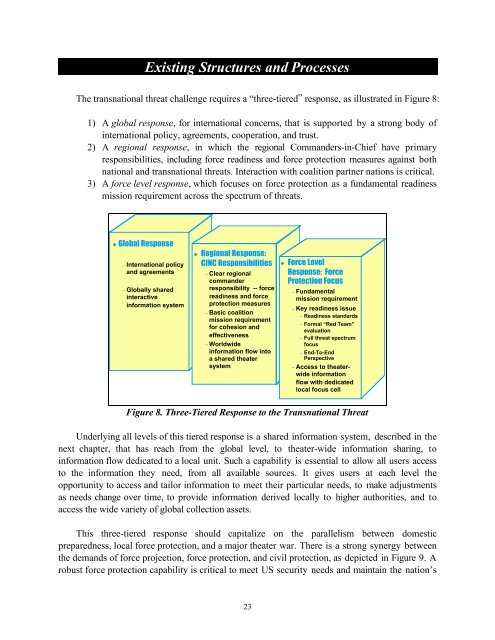DoD Responses to Transnational Threats - The Black Vault
DoD Responses to Transnational Threats - The Black Vault
DoD Responses to Transnational Threats - The Black Vault
You also want an ePaper? Increase the reach of your titles
YUMPU automatically turns print PDFs into web optimized ePapers that Google loves.
Existing Structures and Processes<br />
<strong>The</strong> transnational threat challenge requires a “three-tiered” response, as illustrated in Figure 8:<br />
1) A global response, for international concerns, that is supported by a strong body of<br />
international policy, agreements, cooperation, and trust.<br />
2) A regional response, in which the regional Commanders-in-Chief have primary<br />
responsibilities, including force readiness and force protection measures against both<br />
national and transnational threats. Interaction with coalition partner nations is critical.<br />
3) A force level response, which focuses on force protection as a fundamental readiness<br />
mission requirement across the spectrum of threats.<br />
◆ Global Response<br />
– International policy<br />
and agreements<br />
– Globally shared<br />
interactive<br />
information system<br />
◆ Regional Response:<br />
CINC Responsibilities<br />
– Clear regional<br />
commander<br />
responsibility -- force<br />
readiness and force<br />
protection measures<br />
– Basic coalition<br />
mission requirement<br />
for cohesion and<br />
effectiveness<br />
– Worldwide<br />
information flow in<strong>to</strong><br />
a shared theater<br />
system<br />
◆ Force Level<br />
Response: Force<br />
Protection Focus<br />
– Fundamental<br />
mission requirement<br />
– Key readiness issue<br />
– Readiness standards<br />
– Formal “Red Team”<br />
evaluation<br />
– Full threat spectrum<br />
focus<br />
– End-To-End<br />
Perspective<br />
– Access <strong>to</strong> theaterwide<br />
information<br />
flow with dedicated<br />
local focus cell<br />
Figure 8. Three-Tiered Response <strong>to</strong> the <strong>Transnational</strong> Threat<br />
Underlying all levels of this tiered response is a shared information system, described in the<br />
next chapter, that has reach from the global level, <strong>to</strong> theater-wide information sharing, <strong>to</strong><br />
information flow dedicated <strong>to</strong> a local unit. Such a capability is essential <strong>to</strong> allow all users access<br />
<strong>to</strong> the information they need, from all available sources. It gives users at each level the<br />
opportunity <strong>to</strong> access and tailor information <strong>to</strong> meet their particular needs, <strong>to</strong> make adjustments<br />
as needs change over time, <strong>to</strong> provide information derived locally <strong>to</strong> higher authorities, and <strong>to</strong><br />
access the wide variety of global collection assets.<br />
This three-tiered response should capitalize on the parallelism between domestic<br />
preparedness, local force protection, and a major theater war. <strong>The</strong>re is a strong synergy between<br />
the demands of force projection, force protection, and civil protection, as depicted in Figure 9. A<br />
robust force protection capability is critical <strong>to</strong> meet US security needs and maintain the nation’s<br />
23





![Combat Support in Korea [270 Pages] - The Black Vault](https://img.yumpu.com/49796461/1/190x71/combat-support-in-korea-270-pages-the-black-vault.jpg?quality=85)











